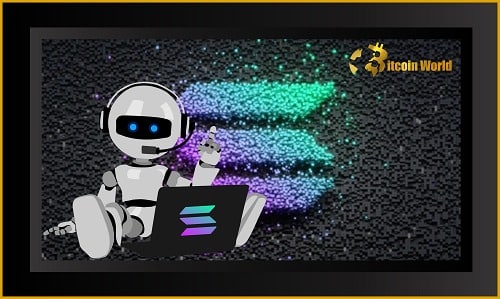Ever experienced the frustration of a website suddenly going down when you’re in the middle of something important? Now imagine that happening with your cryptocurrency transactions. That’s been a reality for some Solana users, a blockchain known for its speed and efficiency. But a series of hiccups has prompted a significant change. Let’s dive into Solana’s recent network challenges and the innovative solution they’re implementing: Google’s QUIC protocol.
The Solana Saga: A Story of Speed Bumps
Solana burst onto the crypto scene with promises of lightning-fast transactions and lower fees, attracting a vibrant community of developers and users. However, the road hasn’t been entirely smooth. Think of it like a high-speed highway encountering unexpected traffic jams.
Remember September of last year? Solana faced a grueling 17-hour outage, essentially grinding to a halt due to a surge in traffic from a DeFi token launch. Then, in April of this year, another 7-hour pause, followed by a 4-hour disruption on June 1st. These weren’t minor glitches; they were significant events that raised concerns about the network’s stability.
What Exactly Went Wrong?
The culprit behind these disruptions was identified as performance issues within the blockchain’s transaction processing unit (TPU). Imagine a super-efficient engine suddenly sputtering. During these outages, the number of transactions Solana could process per second plummeted from thousands to a mere handful. This slowdown effectively brought the network to its knees.
Enter QUIC: Solana’s New Secret Weapon
To understand the fix, let’s first look at the problem. Previously, Solana relied on the User Datagram Protocol (UDP) for its operations. While UDP is known for its speed, it lacks some crucial features for managing heavy traffic and preventing malicious actors from overwhelming the network. Developers have been working tirelessly to stabilize operations, and their solution involves a significant upgrade: replacing UDP with Google’s QUIC protocol.
What is QUIC and Why is it a Big Deal?
QUIC, which stands for Quick UDP Internet Connections, is a modern, encrypted transport layer network protocol. Think of it as a more sophisticated and secure way for data to travel across the internet. Here’s a breakdown of its key advantages:
- Enhanced Security: QUIC incorporates built-in encryption, making it more resistant to eavesdropping and manipulation compared to traditional UDP.
- Improved Speed and Efficiency: Despite being built on UDP, QUIC introduces features like connection multiplexing, which allows multiple data streams to travel over a single connection. This reduces latency and improves overall performance.
- Congestion Control: Crucially for Solana’s issues, QUIC has better congestion control mechanisms. This means it’s better equipped to handle sudden surges in traffic and prevent network overload.
Think of it this way: UDP is like sending individual letters, while QUIC is like sending a well-organized package with multiple items inside, ensuring everything arrives securely and efficiently.
How Will QUIC Help Solana?
Solana’s team believes that QUIC will directly address the issues that led to past outages. The primary goal is to mitigate the impact of bots spamming the network with excessive transactions. By implementing QUIC, Solana aims to:
- Throttle Malicious Traffic: QUIC’s congestion control features can help identify and slow down sources sending an unusually high volume of transactions, preventing them from monopolizing network resources.
- Improve Transaction Processing: By making the data transport layer more efficient, QUIC can contribute to a more stable and reliable transaction processing environment.
- Enhance Network Resilience: The improved security and efficiency of QUIC should make the Solana network more robust and less susceptible to disruptions.
The Bigger Picture: What This Means for Solana and the Crypto World
The adoption of QUIC is a significant step for Solana. It demonstrates a commitment to addressing its network challenges head-on and investing in long-term stability. But what are the broader implications?
- Increased Confidence: A more stable and reliable Solana network can boost confidence among users, developers, and investors. This could lead to greater adoption and further growth within the Solana ecosystem.
- Setting a Precedent: Solana’s experience and its adoption of QUIC could serve as a valuable case study for other blockchains facing similar scalability and stability challenges.
- Competition and Innovation: The constant push for improvement within the crypto space drives innovation. Solana’s move could spur other blockchain platforms to explore similar solutions for enhancing their network performance.
Looking Ahead: A More Robust Solana?
The integration of Google’s QUIC protocol is a promising development for Solana. While it’s not a magic bullet, it represents a significant upgrade to the network’s infrastructure, specifically targeting the vulnerabilities that have caused past disruptions. Will it completely eliminate future outages? Only time will tell. However, this proactive approach signals a strong commitment from the Solana team to build a more reliable and scalable blockchain platform.
For crypto traders, developers, and anyone invested in the Solana ecosystem, this update is a welcome sign. A stable and efficient network is crucial for the long-term success of any blockchain, and Solana’s adoption of QUIC appears to be a significant step in the right direction. Keep an eye on Solana – this could be the turning point towards a smoother, faster, and more dependable experience.
Disclaimer: The information provided is not trading advice, Bitcoinworld.co.in holds no liability for any investments made based on the information provided on this page. We strongly recommend independent research and/or consultation with a qualified professional before making any investment decisions.


